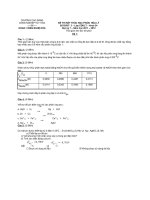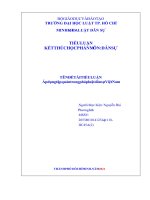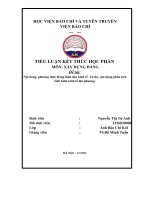báo cáo đồ án kết thúc học phần môn hướng nghiệp 2 đề tài the progess from manufacturer to costumer
Bạn đang xem bản rút gọn của tài liệu. Xem và tải ngay bản đầy đủ của tài liệu tại đây (1.4 MB, 28 trang )
<span class="text_page_counter">Trang 1</span><div class="page_container" data-page="1">
ĐẠI HỌC DUY TÂN VIỆN QUẢN LÝ NAM KHUÊ
---BÁO CÁO ĐỒ ÁN KẾT THÚC HỌC PHẦN MÔN HƯỚNG NGHIỆP 2
ĐỀ TÀI:
The progess from manufacturer to costumer
GVHD: NGUYỄN THỊ MAI DIỆU
</div><span class="text_page_counter">Trang 2</span><div class="page_container" data-page="2">First of all, we would like to send our most sincere thanks to Ms. Nguyen Thi Mai Dieu. During the process of studying and researching career guidance subject 2, we received a lot of attention, help, and guidance. her enthusiasm and dedication. She helped us accumulate more knowledge about this subject so we could complete the essay on the topic: The process from manufacturer to consumer (The process from manufacturer to costumer).
In the process of doing the test, it is certainly difficult to avoid shortcomings. Therefore, we respectfully hope to receive your comments to help my essay become more and more perfect.We sincerely thank you!
</div><span class="text_page_counter">Trang 3</span><div class="page_container" data-page="3">Table of contents
I. Overview of distribution strategy 1. Concept of distribution strategy 2. Types of distribution strategies
3. Factors to consider when building a distribution strategy 4. Steps to building an effective distribution strategy
5. Benefits when implementing an effective distribution strategy 6. Intermediaries in the product distribution campaign
7. Example of distribution strategy II.Collect and process information III. Research results
1. Introduction 2. Distribution process 3. Distribution strategy
4. Customer Interaction and Shopping Experience 5. Technology in the Distribution Process: 6. Market Strategy and Strategic Partners 7. Safety and Security During Distribution
8. Challenges and Opportunities in the Distribution Process 9. Efficiency and Measurement in the Distribution Process 10. Conclusion and Future in the Distribution Process
</div><span class="text_page_counter">Trang 4</span><div class="page_container" data-page="4">Danh mục bảng viết tắt
Hệ thống giúp hoạch định nguồn
lực doanh nghiệp
for Standardizationchuẩn Hóa Quốc<sup>Tổ chức Tiêu</sup> tế
tồn cầu
hiệu quả cơng
</div><span class="text_page_counter">Trang 5</span><div class="page_container" data-page="5">Danh mục hình vẽ
</div><span class="text_page_counter">Trang 6</span><div class="page_container" data-page="6">I. Overview of distribution strategy
1. Concept of distribution strategy.
A distribution strategy is a process to get a service or product from the manufacturer to the consumer. Includes decisions about distribution channels, processes, storage, order processing and shipping to ensure products reach customers at the right time, place and quantity.
Picture 1.1
Distribution strategy is extremely important to the business success of a business. The more effective this strategy is, the more satisfied and loyal customers will be, and the more cost-effective the operation will be, the more the business can grow and reach more new customers.
2. Types of distribution strategies:
Mass distribution strategy: this is a form in which the product and service provider reaches as many intermediaries as possible. The mass distribution strategy is applied to the vast majority of consumer goods, such as raw foods, fruits and vegetables, household appliances, beverages,...
</div><span class="text_page_counter">Trang 7</span><div class="page_container" data-page="7">Exclusive distribution strategy: this is a strategy to limit the number of intermediaries, applied to expensive, limited goods that require extremely high levels of service and technology. This strategy helps businesses easily manage and protect brand and customer images.
Hình 1.2
Intensive distribution strategy: with this distribution strategy, the product is introduced into as many retail locations as possible, trying to cover as many markets as possible, such as soft drinks that are put into convenience stores, grocery stores, vending machines, etc.
Selective distribution strategy: is a choice between intensive and exclusive distribution strategies. The product will be distributed in many locations but not as many as an intensive distribution strategy. This form helps create hidden messages about the brand and increases the chance of buying genuine products from buyers. This strategy is common in shopping centers, brands will be carefully thought out by manufacturers to locate their headquarters - places with high consumer demand, distributing customers in the most convenient way, for example, including brands Charles & Keith, H&M,...
</div><span class="text_page_counter">Trang 8</span><div class="page_container" data-page="8">3. Factors to consider when building a distribution strategy
The type of product: different features of services and services will be appropriate for different distribution strategies. For example, fast consumer products are often widely distributed, whereas advanced products are usually used in exclusive distribution.
Target markets: The distribution strategy should be consistent with the market object that business is targeting. For example, if business market objects are young consumers, can use online distribution channels or retail stores in urban areas.
Business goals are needed to support business goals such as increasing sales, opening markets or increasing brand recognition.
Entries: The competition needs to consider the distribution of competitions to ensure that the strategy of the competition is in order to ensure that the strategy of the competition is in place.
The dumps, transportation: The storage process along with the shipping process is a factor to consider when the business builds the distribution strategy. For example, if the business chooses to choose the direct distribution method, they will need to have a warehouse to store goods, transportation, management, storage, storage arrangements, and the delivery work.
Hình 1.3
</div><span class="text_page_counter">Trang 9</span><div class="page_container" data-page="9">4. The Steps to Effective Distribution Strategy
Step 1: Select Client Objects
First of all, businesses need to know their target client's focus is ai; each client needs a different approach strategy because the needs and expectations of the customers in the market are getting more and more diverse today.
When building customer portraits, business can answer the following questions: 1. Who are our customers?
2. How do they usually make purchases? 3. What are their shopping needs?
4. What do they expect from the company's products/services? 5. ...
The responses to these questions will directly impact the distribution strategy that the business is implementing. The process of gaining customer trust and brand selection is challenging if the product does not meet their needs or align with market demands.
Step 2: Define the Brand's Product
Next, businesses need to identify the product they want to target to a specific audience. To do this, businesses need to understand the following two aspects clearly:
1. Brand Assets: This factor helps businesses understand their position and value in the market. A strong brand asset will provide significant advantages, enabling businesses to be flexible in implementing marketing strategies and setting targets with their distribution partners.
2. Product Categories: Depending on the types of products a business deals with, they should determine the most suitable distribution strategy. To identify this, besides conducting internal research, businesses also need to conduct market research targeting their audience. Creating a SWOT analysis table to study the market is the simplest and most effective way to support businesses in this step.
</div><span class="text_page_counter">Trang 10</span><div class="page_container" data-page="10">Step 3: Selecting Distribution Channels
After analyzing customers, products, and the market, businesses need to choose suitable distribution channels to integrate into their strategies. For small-scale businesses, utilizing a direct distribution strategy is a fitting choice. Additionally, they may consider incorporating some intermediary channels as it can help reduce costs and mitigate risks to some extent.
At the same time, businesses should also pay attention to logistics. Renting or building additional warehouses, investing in delivery teams and transportation vehicles, along with focusing on training sales skills for employees and marketing, will contribute to the business's development process.
Step 4: Distribution Channel Management
Finally, businesses need to meticulously manage their distribution channels throughout the implementation of their distribution strategy. The distribution channels need to meet the following criteria adequately:
1. Quality: The distribution channel management team and sales force need to be equipped with comprehensive sales skills and market access capabilities. 2. Function: Personnel need to have a clear understanding of the goals,
functions, requirements, and authority of the distribution channel they are involved in. Businesses need to provide training to develop skills, share vision, and mission for channel members. Additionally, establishing policies on rewards and penalties will help enhance the quality of the workforce. 3. Policies: Distribution channels need to fully implement the advertising,
discount, and promotion policies set by the business.
4. Quality: The distribution channel management team and sales force need to be equipped with comprehensive sales skills and market access capabilities. 5. Function: Personnel need to have a clear understanding of the goals,
functions, requirements, and authority of the distribution channel they are
</div><span class="text_page_counter">Trang 11</span><div class="page_container" data-page="11">involved in. Businesses need to provide training to develop skills, share vision, and mission for channel members. Additionally, establishing policies on rewards and penalties will help enhance the quality of the workforce. 6. Policies: Distribution channels need to fully implement the advertising, discount, and promotion policies set by the business.Hình 1.4
5. Benefits of implementing an effective distribution strategy include:
Knowing how to develop and implement a product distribution strategy brings several benefits:
Cost savings: Businesses can easily make cost-saving decisions such as cutting ineffective intermediary channels, minimizing transportation and warehousing costs. Additionally, the quality of intermediary channels also contributes to reducing manufacturing costs for the business.
Market expansion: A distribution strategy can be envisioned as a detailed map of goods circulation. By using intermediary channels, products can reach consumers quickly, thereby expanding the distribution network and customer reach.
Tight control: A distribution strategy helps businesses understand and control every step in the distribution process, ensuring that goods reach customers promptly.
Easy feedback collection: Not only collecting information from customer feedback, but also gathering data on sales volume, quantity of goods sold, and order lead times from distributors. This information helps businesses
</div><span class="text_page_counter">Trang 12</span><div class="page_container" data-page="12">assess the product's market position and supports the process of making appropriate adjustments to meet consumer needs.
Enhancing core business value: Businesses can shape the value of their products and brand image in the market through decisions to limit or expand their product range.
Accelerating growth: With an effective product distribution strategy, businesses can quickly expand their market share. Intermediary channels also play a crucial role in reaching customers that businesses cannot reach, thereby expanding the customer base and accelerating business growth.
Improving marketing campaign effectiveness: Businesses can combine general advertising campaigns with intermediary channels. This helps attract customers more easily and evenly distribute advertising costs.
6. The intermediaries in a product distribution campaign.
Retailers: Retailers are entities that engage directly with customers. They may purchase goods from manufacturers or through wholesalers. The wholesale prices that retailers purchase goods are often lower than the suggested retail prices offered by manufacturers, ensuring profitability when selling products to customers.
Hình 1.5 Hình 1.6
Wholesalers: Wholesalers are entities that seek large quantities of products from multiple manufacturers and then deliver these products to retailers or distributors. Wholesalers always strive to purchase goods at the lowest possible cost, creating a price difference between the purchase price and the selling price to increase profitability. To ensure this, wholesalers need to own multiple warehouses and a diverse range of goods to provide retailers with a wide selection of options.
</div><span class="text_page_counter">Trang 13</span><div class="page_container" data-page="13">Franchisors: Franchisors can be individuals, businesses, corporations, or government entities with significant financial resources. With the desire to invest and conduct business to achieve higher profits than the interest rate at banks, while also increasing brand recognition.
Distributor: A distributor is responsible for transporting goods from the place of production to retail points. With a distributor, manufacturers do not need to manage a workforce or incur costs such as salaries and bonuses. Distributors often own a packaging system for products to deliver to retailers.
7. Example about distribution strategy
Example 1: Apple employs a selective distribution strategy to bring its products to consumers' hands. They only distribute products through authorized retail partners such as Apple Stores and mobile phone retailers. This strategy brings significant benefits to Apple. Thanks to this strategy, they have better control over product quality and provide excellent customer service.
Hình 1.7
Example 2: The watch company Rolex implements an exclusive distribution strategy to distribute its products to consumers. They choose to collaborate with authorized retail partners such as upscale watch retailers. Through this strategy, Rolex maintains the exclusivity of its products and ensures the highest quality of service for customers.
</div><span class="text_page_counter">Trang 14</span><div class="page_container" data-page="14">The product distribution strategy always plays a crucial role in the business operations of every enterprise. A successful distribution campaign is not only evident in economic aspects but also reflected through consumer evaluations of the business. Therefore, understanding how to construct a distribution strategy will be a determining factor in helping enterprises move closer to success.
Hình 1.8
</div><span class="text_page_counter">Trang 15</span><div class="page_container" data-page="15">II. Collecting and processing information
1. Data Collection:
Gather data about products, sales points, and customers.
Collect transportation and storage data from shipping partners and warehouses. 2. Data Analysis:
Utilize data analysis tools like Excel to analyze collected data.
Analyze data on current transportation models, delivery times, shipping costs, and customer satisfaction.
3. Building Predictive and Optimization Models:
Apply prediction methods such as demand forecasting, delivery time prediction to optimize the distribution process.
Use optimization methods like Linear Programming, Integer Programming to optimize transportation routes and goods distribution.
4. Designing New Distribution Strategies:
Consider factors such as warehouse network, transportation routes, and customer requirements.
Based on data analysis and modeling, design new distribution strategies to improve efficiency and reduce transportation costs.
5. Implementation and Monitoring:
Implement new distribution strategies and monitor performance by comparing with previous performance indicators like delivery times, shipping costs, and customer satisfaction.
Adjust strategies based on feedback and new data to continuously improve the distribution process.
</div><span class="text_page_counter">Trang 16</span><div class="page_container" data-page="16">6. Research Directories and Industry Books:
Look for books and industry directories on supply chain management, logistics, and marketing to gain an overview of the process from manufacturing to consumers. 7. Internet Research:
Use search engines to find articles, papers, and online resources from reputable sources such as research organizations' websites, universities, or government agencies.
8. Read Reports and Original Research:
Review reports from international organizations, research institutions, or management agencies on trends and challenges in the manufacturing and distribution process.
9. Conduct Surveys:
If possible, create and conduct a survey to gather data from businesses, manufacturers, or consumers about their perspectives and experiences with this process.
10. Utilize Statistical Data:
Use statistical data from sources such as national or international statistical agencies to support and illustrate trends and key figures.
11. Data Analysis:
Process collected data to draw conclusions and conduct in-depth analysis of the process from manufacturing to consumers.
12. Comparison and Cross-Referencing:
Compare information and data from multiple sources to gain a comprehensive view and cross-reference information.
</div>








